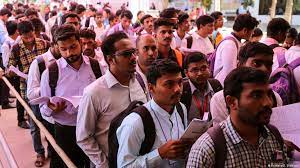Unemployment rate in India inched higher to 7.45% in February 2023 from 7.14% in January 2023, taking the total number of unemployed in the country to 33 million compared to 31.5 million in January. – The Economic Times
Unemployment in India is a persistent problem that has far-reaching consequences for the nation’s Economic, Social and political stability. With a population of over 1.3 billion and a rapidly growing workforce, India faces the daunting challenge of creating enough Jobs to absorb the millions of new entrants to the labour market each year. In this essay, I will explore the causes and types of Unemployment in India, examine the effects on the economy, society and individuals and discuss Government initiatives to tackle the issue. It is my contention that addressing Unemployment in India is crucial to realising the country’s potential as a global Economic powerhouse and ensuring the well-being of its citizens.
Causes of Unemployment in India
Unemployment is a significant issue in India, with a large number of people not having access to Job opportunities. There are various factors that contribute to the high levels of Unemployment in the country, which can be broadly categorised into four main causes. These are –
Lack of Education and Skills-
One of the primary reasons for Unemployment in India is the lack of education and Skills among the workforce. Many people in the country are unable to acquire the necessary Skills and knowledge required for the Jobs that are available. This is partly due to the poor quality of education in many parts of the country, as well as the high cost of education that puts it out of reach for many.
Rapid Population Growth-
India has a rapidly growing population, which puts a strain on the available Job opportunities. The number of people entering the workforce each year is significantly higher than the number of Jobs being created, leading to a large number of people being unemployed.
Economic Slowdown and Globalization-
India’s economy has been facing challenges in recent years, with a Slowdown in growth and a rise in inflation. Globalisation has also affected the country’s Job market, with many Jobs being outsourced to other countries. The country’s traditional industries, such as agriculture and textiles, have been hit hard by Globalization, leading to a decrease in employment opportunities.
Automation and Technological Advancement-
Automation and technological advancements have led to a decrease in the number of Jobs available in certain sectors. Machines and robots are now being used in industries such as manufacturing and agriculture, leading to a decrease in the need for human labor. This trend is expected to continue in the coming years, leading to further Unemployment in these sectors.
Types of Unemployment in India
Unemployment can be classified into different types based on its causes and characteristics. The following are the four types of Unemployment that are commonly observed in India:
Structural Unemployment –
Structural Unemployment occurs when there is a mismatch between the skills of job seekers and the available jobs in the market. This type of Unemployment arises due to changes in the structure of the economy, such as shifts in the demand for labor or technological advancements that render certain skills obsolete. In India, structural Unemployment is often observed in sectors such as agriculture and manufacturing, where workers lack the skills required for the modern economy.
Cyclical Unemployment
Cyclical Unemployment is caused by fluctuations in the business cycle. During a recession, when economic activity slows down, businesses tend to lay off workers to cut costs. Conversely, during a period of economic expansion, businesses tend to hire more workers to meet the growing demand. In India, cyclical Unemployment is often observed in sectors such as construction and real estate, which are highly sensitive to changes in economic activity.
Seasonal Unemployment
Seasonal Unemployment occurs when certain industries experience fluctuations in demand based on the season. For example, the demand for agricultural labor is higher during the planting and harvesting seasons but lower during other times of the year. Similarly, the demand for tourism-related jobs is higher during the peak tourist season but lower during the off-season. Seasonal Unemployment is common in India, particularly in the agricultural and tourism sectors.
Disguised Unemployment
Disguised Unemployment refers to a situation where a larger number of people are employed in a sector than is necessary. In disguised Unemployment, the marginal productivity of labour is zero, meaning that removing some workers would not affect the output of the sector. This type of Unemployment is often observed in the agricultural sector, where large numbers of people are employed in small plots of land, resulting in low levels of productivity.
Effects of Unemployment in India
Unemployment has various negative effects on individuals, families and the overall economy of the country. India has been struggling with high Unemployment rates for several years and the effects of Unemployment are felt in various sectors of the economy. Here are some of the major effects of Unemployment in India-
Economic Consequences-
Unemployment has several Economic consequences in India. Firstly, it leads to a loss of output and production, as the unemployed are not contributing to the country’s GDP. This leads to a reduction in Economic growth and development. Secondly, Unemployment leads to a reduction in consumption, as the unemployed have lower disposable incomes and are therefore unable to purchase goods and services. This, in turn, leads to a reduction in demand and a Slowdown in Economic activity. Lastly, Unemployment leads to an increase in Government expenditure on Social welfare programs, as the Government needs to provide financial assistance to the unemployed.
Social Consequences-
Unemployment also has several Social consequences in India. Firstly, it leads to an increase in poverty, as the unemployed are unable to provide for themselves and their families. This leads to a reduction in the standard of living and an increase in Social inequality. Secondly, Unemployment leads to an increase in crime, as the unemployed may resort to illegal activities to make a living. This, in turn, leads to a breakdown in Social order and stability. Lastly, Unemployment leads to an increase in Social unrest, as the unemployed may become disgruntled with the Government and demand change.
Psychological Consequences-
Unemployment also has several psychological consequences in India. Firstly, it leads to a loss of self-esteem and confidence, as the unemployed may feel useless and devalued. This, in turn, leads to mental health issues such as depression and anxiety. Secondly, Unemployment leads to a loss of Social status and identity, as the unemployed may be stigmatised by society and their families. This, in turn, leads to a breakdown in Social relationships and support systems. Lastly, Unemployment leads to a loss of motivation and ambition, as the unemployed may feel hopeless and helpless about their future prospects.
In conclusion, Unemployment has various negative effects on the economy, society and individuals in India. It leads to a loss of output, production and consumption, as well as an increase in poverty, crime and Social unrest. It also leads to a loss of self-esteem, confidence and motivation, as well as mental health issues such as depression and anxiety. The Government needs to take effective measures to tackle Unemployment and mitigate its negative consequences on the country.
Government Initiatives to Tackle Unemployment in India
Unemployment is a major challenge in India and the Government has been taking several initiatives to tackle this issue. The Government has launched various programs and campaigns aimed at promoting Skill development, entrepreneurship and employment generation. Here are some of the key Government initiatives to tackle Unemployment in India-
Skill Development Programs-
“Skill development is essential to address unemployment in India. By 2022, India needs to create 500 million skilled workers to meet the demands of the workforce.” – National Skill Development Corporation (NSDC)
The Indian Government has launched several Skill development programs aimed at providing vocational training to the unemployed youth in the country. These programs are designed to equip the youth with the necessary Skills required for the Job market. The National Skill Development Corporation (NSDC), a public-private partnership, has been established to oversee and implement these programs. The NSDC offers courses in various sectors such as construction, tourism, retail and healthcare. Through these programs, the Government aims to bridge the gap between industry requirements and the Skills of the workforce.
Rural Employment Generation Programs-
The Indian Government has initiated various programs to create employment opportunities in rural areas. These programs are aimed at providing employment to the rural population and preventing migration to urban areas in search of employment. The Mahatma Gandhi National Rural Employment Guarantee Act (MGNREGA) is one such program that provides employment opportunities in various sectors such as agriculture, horticulture and construction. The program aims to guarantee 100 days of wage employment to each household in rural areas.
Make in India Campaign-
The Make in India campaign is an initiative launched by the Indian Government aimed at promoting investment, innovation and manufacturing in the country. The campaign aims to create a conducive environment for businesses to invest in India and create Job opportunities for the people. The Government has initiated various policy changes such as simplifying procedures for setting up businesses, providing incentives for investment and increasing focus on manufacturing to boost Job creation. The campaign has attracted significant investment from both domestic and foreign investors and has created a large number of Job opportunities in various sectors.
Startup India Campaign-
The Startup India campaign is an initiative launched by the Indian Government aimed at promoting entrepreneurship and creating Job opportunities for the youth in the country. The campaign provides a platform for startups to showcase their ideas and get support from the Government. The Government provides various incentives such as tax exemptions, funding and mentorship to encourage startups and create a startup-friendly ecosystem in the country. The campaign has led to the creation of several innovative startups and has created Job opportunities in various sectors such as technology, e-commerce and healthcare.
This essay has examined the issue of Unemployment in India, its causes, effects and Government initiatives to tackle the problem. The causes of Unemployment in India include a lack of education and Skills, rapid population growth, Economic Slowdown and Globalization and automation and technological advancement. The effects of Unemployment include Economic, Social and psychological consequences. The Government has implemented various initiatives to tackle Unemployment, including Skill development programs, rural employment generation programs, the Make in India campaign and the Startup India campaign.
To address the issue of Unemployment in India, the Government needs to take more proactive and comprehensive measures. Firstly, there is a need to invest in education and Skill development programs, which will equip young people with the necessary Skills to enter the Job market. Secondly, the Government needs to focus on promoting entrepreneurship and small business development, which will create Jobs and stimulate Economic growth. Thirdly, there is a need to invest in rural infrastructure development, which will create Job opportunities in rural areas and reduce migration to urban centres. Finally, the Government needs to address structural issues in the economy, such as labour market rigidities and regulatory hurdles, which hinder Job creation and Economic growth.
Unemployment is a serious issue in India that affects millions of people and has significant negative consequences on the economy and society. The Government needs to adopt a multi-faceted approach to tackle the problem, which includes investment in education and Skill development, promotion of entrepreneurship and small business development, investment in rural infrastructure and addressing structural issues in the economy. By taking these steps, the Government can create a more vibrant and inclusive Job market that benefits all sections of society. It is only through such proactive and comprehensive measures that the issue of Unemployment can be effectively addressed and the country can move towards a more prosperous and equitable future.



